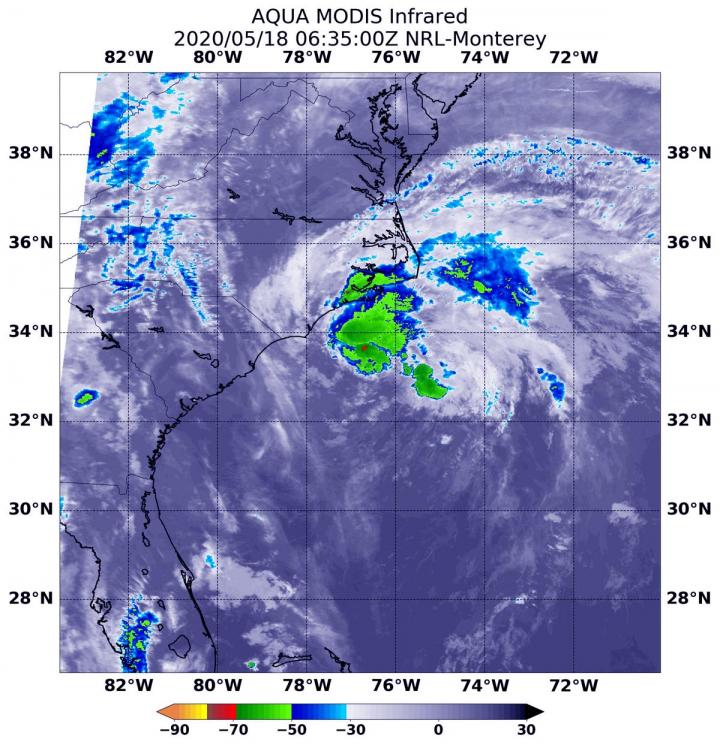
Credit: Credit: NASA/NRL
Infrared imagery from NASA’s Aqua satellite and radar imagery revealed that Tropical Storm Arthur remains poorly organized. Strongest storms, according to the Aqua data, appeared along and off the southeastern coast of North Carolina.
Warnings and Watches
On May 18, a Tropical Storm Warning is in effect from Surf City to Duck, North Carolina, and for the Pamlico and Albemarle Sounds.
Satellite Imagery
NASA’s Aqua satellite used infrared light to analyze the strength of storms and found the center of circulation was displaced from the bulk of them. Infrared data provides temperature information, and the strongest thunderstorms that reach high into the atmosphere have the coldest cloud top temperatures.
On May 18 at 2:35 a.m. EDT (0635 UTC), the MODIS instrument that flies aboard NASA’s Aqua satellite showed strongest storms in Tropical Storm Arthur were along the southeastern coast of North Carolina and just off-shore. Those strong storms contained cloud top temperatures were as cold as minus 63 degrees Fahrenheit (minus 52.7 Celsius). Cloud top temperatures that cold indicate strong storms with the potential to generate heavy rainfall.
MODIS imagery showed the low-level center located near the southwestern edge of a complex of ragged convective bands.
Status on May 18, 2020
At 8 a.m. EDT (1200 UTC), the National Hurricane Center (NHC) reported the center of Tropical Storm Arthur was located near latitude 34.5 north, longitude 75.9 west. Arthur was moving toward the north-northeast near 15 mph (24 kph). A turn toward the northeast with an increase in forward speed is expected later today, followed by a turn toward the east on Tuesday.
Maximum sustained winds are near 45 mph (75 kph) with higher gusts. While some strengthening is forecast during the next 48 hours, Arthur is likely to lose its tropical characteristics on Tuesday. Tropical-storm-force winds extend outward up to 90 miles (150 km) mainly to the east of the center.
The estimated minimum central pressure reported from an Air Force Reserve Hurricane Hunter aircraft is 1001 millibars.
Rip Currents and Life-Threatening Surf Along Coastal Areas
Swells generated by Arthur are affecting portions of the southeast U.S. coast and are expected to spread northward along the U.S. mid-Atlantic coast during the next day or two. NHC cautioned, “These swells could cause life-threatening surf and rip current conditions.”
Arthur’s Forecast Path
At 5 a.m. EDT on May 18, 2020, NOAA’s National Hurricane Center noted that Arthur’s movement is going to be affected by two factors: “A baroclinic trough (elongated area of low pressure) and associated surface front approaching from the west should cause Arthur to turn northeastward during the next several hours. The forecast track shows the center passing near or just offshore of the North Carolina Outer Banks. By Tuesday and Tuesday night, Arthur will be entering the strong mid-latitude Westerlies, which will steer cyclone eastward in a day or two.”
###
For updated forecasts, visit: https:/
By Rob Gutro
NASA’s Goddard Space Flight Center
Media Contact
Rob Gutro
[email protected]
Original Source
https:/




